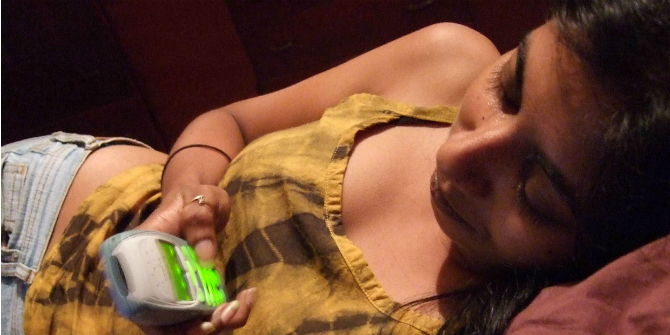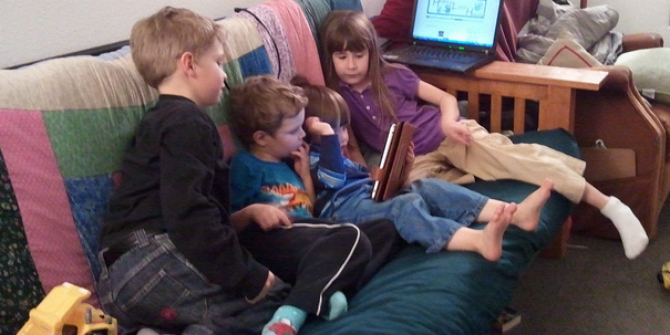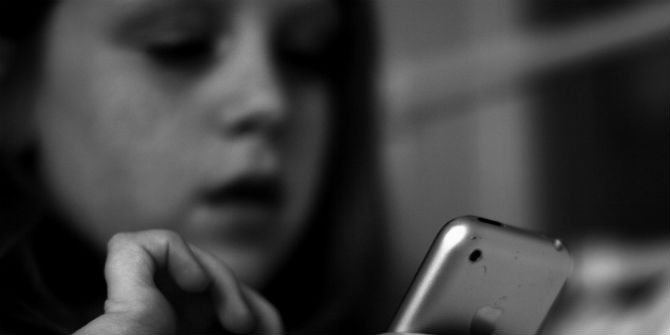 In a response to a previous blog on this site about the Netflix TV series 13 Reasons Why, Richard Graham presents his perspective as a practising psychiatrist on the issues that it raised around media portrayal and reporting of suicide, and suicide more broadly. Richard argues that such debates present an important opportunity to create greater public awareness of the issues surrounding suicide, and considers whether such a graphic depiction of suicide in this programme was necessary. Richard is a consultant child and adolescent psychiatrist and clinical lead to the Good Thinking project: the London digital mental well-being service. He is also on the executive board of the UK Council for Child Internet Safety and co-chairs the Digital Resilience Working Group. [Header image credit: Pixabay by Mojzagrebinfo].
In a response to a previous blog on this site about the Netflix TV series 13 Reasons Why, Richard Graham presents his perspective as a practising psychiatrist on the issues that it raised around media portrayal and reporting of suicide, and suicide more broadly. Richard argues that such debates present an important opportunity to create greater public awareness of the issues surrounding suicide, and considers whether such a graphic depiction of suicide in this programme was necessary. Richard is a consultant child and adolescent psychiatrist and clinical lead to the Good Thinking project: the London digital mental well-being service. He is also on the executive board of the UK Council for Child Internet Safety and co-chairs the Digital Resilience Working Group. [Header image credit: Pixabay by Mojzagrebinfo].
The recent blog from the LSE on the Netflix series 13 Reasons Why caused me considerable unease, if, on balance, wrongly. Perhaps overidentified with all of those practitioners currently supporting suicidal young people, I felt Netflix was playing fast and loose with those at risk, and worse, seemed to have raised further concern with Series 2 of 13 Reasons Why. It may seem obvious that clinicians worry about the risk of suicide, but much of this is rooted in evidence and experience, and not free-floating anxiety. The fear is that the reporting of, or portrayal of, suicide in a drama could unduly influence or ‘trigger’ a vulnerable person into attempting suicide themselves. It would not be the sole cause, but in a range of ways it could reinforce the urge to die. This was an area the Netflix-funded research into the impact of watching 13 Reasons Why had on young people, could not ethically address. Before considering how 13 Reasons Why differs from other dramatic portrayals of suicide, with its graphic and detailed portrayal of Hannah’s death, it is worth revisiting the complex cultural, research and practice context in which suicide prevention initiatives exist.
Suicide, along with some others, such as group contagion, is one of the least understood aspects of human behaviour. Our cultural attitudes to suicide are troubling and up until 1961 suicide was illegal in the United Kingdom; anyone attempting suicide who did not die, could be imprisoned. Before this, suicides were viewed as acts of blasphemy and those who died were not given a Christian burial, but were buried at crossroads. This gives some hint at the anger and agony a suicide can engender. It might also make sense of how some self-harm or ‘right to die’ online groups are not just anti-psychiatry, they are political or counter-culture. As seen in some cases of an eating disorder, when all else in life seems to be beyond our control, our sovereignty over our bodies and life itself can be used desperately. Hunger strikes, self-immolation and more recent suicide bombers show how political a suicide can be.
Yet despite decades of research, our knowing who is at risk, and if so, when they are at risk, is still at an early stage. Understanding which factors differentiate between those who will have thoughts of suicide, and those who will act upon those thoughts and attempt suicide, remains elementary [1]. Currently the main focus of a suicide risk assessment is to characterise and quantify risk through identifying demographic risk factors, though these may be as common in the general public as they are in suicidal individuals [2]. Demographic risk factors increase the suicide risk of a whole population across its lifetime, but do not predict suicide in an individual at a single time-point. Further, an absence of risk factors does not mean the absence of a risk of suicide [3]. Consequently research to guide a practitioner, family or teacher in any way that gives confidence is limited. Risk assessment, often felt to be of someone, rather than for someone, is often seen as essential in practice, yet remains a poor guide. Attempts to understand the person, and bear with compassion the hopelessness that they feel may offer more.
What is perhaps better understood is that media can play a role in suicidal behaviour. When Goethe’s novella The Sorrows of Young Werther was published in 1774, young men (suffering from ‘Werther fever’) would dress in the style of the romantic and heroic protagonist of the work. But a number also ended their lives by suicide, in the same manner as the protagonist, and so this appears to be one of the first accounts of copycat suicides, and triggered by a work of fiction. There are guidelines for journalists on how to report responsibly on suicide. Both the Samaritans and Beat have excellent media guidelines for any portrayal or reporting on suicide and eating disorders in both the news and in drama portrayal:
Tips from the Samaritans’ factsheet on drama portrayal include:
- Use as little detail as possible about the suicide method in any dramatic portrayal, to avoid unduly influencing the behaviour of vulnerable people.
- The moment of death should never be broadcast and, if possible, entirely avoid showing the act of suicide – allude to it only.
Media reporting of a suicide is a complex matter as many who experience suicidal thoughts experience them as traumatic and intruding into the mind in the most disturbing manner. An open acknowledgement and discussion of suicidal thoughts may also reduce their impact and lessen distress.
And so if media can trigger suicidal behaviour, can we understand the process better? Looking at the impact on viewers of suicides portrayed in films, Till et al [4] concluded:
The effects of suicide-related media material seem to vary with individual vulnerability and with type of media portrayal. Individuals with lower vulnerability experience more emotional reactions when exposed to a film culminating in suicide, but individuals with higher vulnerability experience a rise in suicidal tendencies particularly if they identify with the protagonist who died by suicide. In contrast, portrayals of individual mastery of crisis may have beneficial effects in more vulnerable individuals.
Thus, in considering the impact of a drama or a media report we have to consider the vulnerability of the individual accessing it, but also whether or not there is present some degree of hope, such that an individual might overcome their difficulties.
So where does that take us in consideration of 13 Reasons Why? Firstly, I suspect the background to 13 Reasons Why is more harrowing than the show itself. Rooted, one suspects, in the distressing communication by Amanda Todd on YouTube before she ended her life, there is considerable value ln communicating compassionately about the appalling lives that some young people live. Media and drama, at their best can address matters powerfully and movingly. In a thoughtful blog from Professor Rory O’Connor of the Suicidal Behaviour Research Lab, he comments:
The series deals with really important issues: including objectification, sexual assault, social disconnection, thwarted love, shame and social perfectionism. These are all issues we need to discuss more openly. Therefore, we need to be careful that we do not shut down the discussion around 13 Reasons Why; inadvertently the backlash could be misinterpreted by vulnerable young people as, ‘it is not okay to talk about suicide’.
However, he continues (and hence my unease as a practitioner):
Whereas there were breaches of the media suicide reporting guidelines sporadically in the earlier episodes, the actual coverage of Hannah’s suicide is unacceptable, being graphic and gratuitous – and is contrary to all of the guidelines about not providing a detailed depiction of method of death. I don’t agree with the producers’ justification for it being so graphic. More generally, the portrayal of Hannah’s suicide as inevitable, that suicide is the only option is also unhelpful and incorrect. Many viewers may also be left with the message that suicide is driven by vengeful motives, that help-seeking gets you nowhere and that the aftermath of suicide can be somewhat glamorous. Such portrayals add to the myths and stigma around suicide.
It is here we reach the crux; if it is based on the life of Amanda Todd, she died by suicide, and it would be glib for anyone to suggest that recovery from her life’s traumas would have been easy or brief for her. Many with lived experience may also agree that seeking help gets you nowhere, and may feel punished as those who struggled before were. But this is not the case for all, and some who may have a good chance of recovery could be nudged in the wrong direction by 13 Reasons Why. The evidence may be neither straightforward nor substantial, but it is clear that the series could have been more sensitive and better; the approach taken is not free of risk.
Curiously, clinical work during the period when 13 Reasons Why reached public consciousness did enable a certain self-regulation, by both media and individuals, which protected many. The furore (felt by some to be moral panic) certainly led to clearer warnings, and those most vulnerable told me that under no circumstances would they watch the series, fearing it could ‘trigger’ something for them. But they also did not, in their avoidance, believe the producer understood the concerns. Many who had watched it reported that they found it cold and cynical.
It is not for content creators to present a world that is false in its positivity or unrelatable when capturing the actual lives some young people have. But 13 Reasons Why could have, no, should have, been better and should have avoided those gratuitous elements that we know can trigger a vulnerable person into the worst action. I suspect many young people believe the ‘graphic and gratuitous’ aspects are but further examples of an adult world that exploits even the actual death of a young person.
Avoid.
Notes
[1] Klonsky, E. D., & May, A. M. (2014). Differentiating Suicide Attempters from Suicide Ideators: A Critical Frontier for Suicidology Research. Suicide and Life-Threatening Behavior, 44 (1), 1–5; O’Connor, R. C., & Nock, M. K. (2014). The psychology of suicidal behaviour. The Lancet Psychiatry, 1 (1), 73–85.
[2] Cole-King A, Lepping, P. (2010). Suicide mitigation: time for a more realistic approach. British Journal of General Practice, 60 (570), 3-4
[3] Cole-King A, Garett V, Williams H, Hines K, Platt S. (2013). Suicide mitigation embedding compassion in clinical care. Advances in Psychiatric Treatment, 19, 276-283.
[4] Till, B., Strauss, M., Sonneck, G., & Niederkrotenthaler, T. (2015). Determining the effects of films with suicidal content: A laboratory experiment. British Journal of Psychiatry, 207 (1), 72-78.
This post gives the views of the authors and does not represent the position of the LSE Parenting for a Digital Future blog, nor of the London School of Economics and Political Science.





